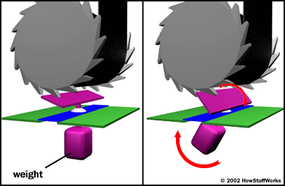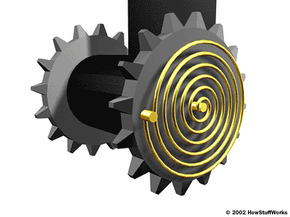Extend and Retract
In a typical seat belt system, the belt webbing is connected to a retractor mechanism. The central element in the retractor is a spool, which is attached to one end of the webbing. Inside the retractor, a spring applies a rotation force, or torque, to the spool. This works to rotate the spool so it winds up any loose webbing.
When you pull the webbing out, the spool rotates counterclockwise, which turns the attached spring in the same direction. Effectively, the rotating spool works to untwist the spring. The spring wants to return to its original shape, so it resists this twisting motion. If you release the webbing, the spring will tighten up, rotating the spool clockwise until there is no more slack in the belt.
Advertisement
The retractor has a locking mechanism that stops the spool from rotating when the car is involved in a collision. There are two sorts of locking systems in common use today:
- systems triggered by the car's movement
- systems triggered by the belt's movement
The first sort of system locks the spool when the car rapidly decelerates (when it hits something, for example). The diagram below shows the simplest version of this design.

The central operating element in this mechanism is a weighted pendulum. When the car comes to a sudden stop, the inertia causes the pendulum to swing forward. The pawl on the other end of the pendulum catches hold of a toothed ratchet gear attached to the spool. With the pawl gripping one of its teeth, the gear can't rotate counterclockwise, and neither can the connected spool. When the webbing loosens again after the crash, the gear rotates clockwise, and the pawl disengages.

The second kind of system locks the spool when something jerks the belt webbing. The activating force in most designs is the speed of the spool rotation. The diagram shows a common configuration.
The central operating element in this design is a centrifugal clutch— a weighted pivoting lever mounted to the rotating spool. When the spool spins slowly, the lever doesn't pivot at all. A spring keeps it in position. But when something yanks the webbing, spinning the spool more quickly, centrifugal force drives the weighted end of the lever outward.
The extended lever pushes a cam piece mounted to the retractor housing. The cam is connected to a pivoting pawl by a sliding pin. As the cam shifts to the left, the pin moves along a groove in the pawl. This pulls the pawl into the spinning ratchet gear attached to the spool. The pawl locks into the gear's teeth, preventing counterclockwise rotation.
In some newer seat belt systems, a pretensioner also works to tighten the belt webbing. In the next section, we'll see how these devices work.
